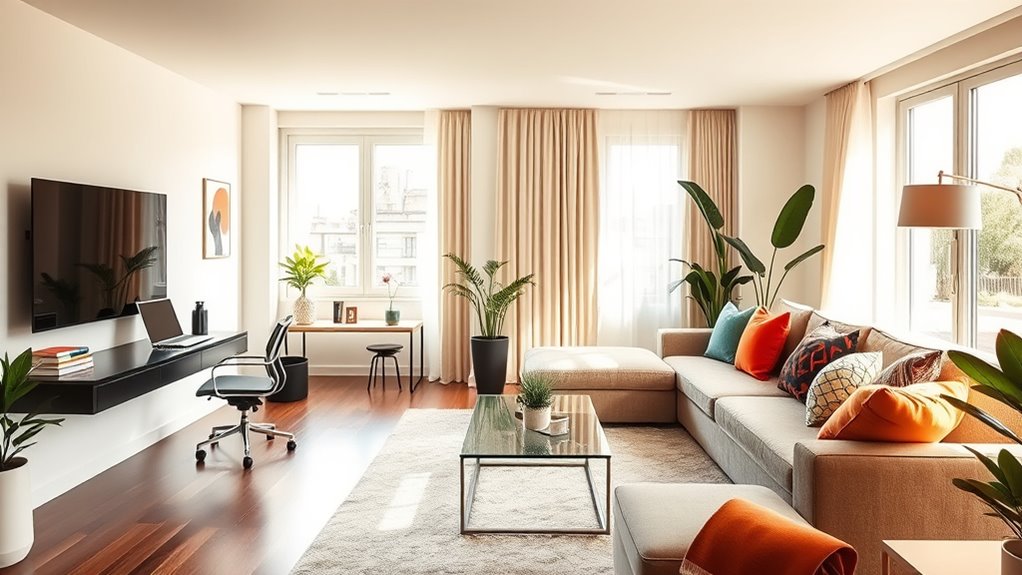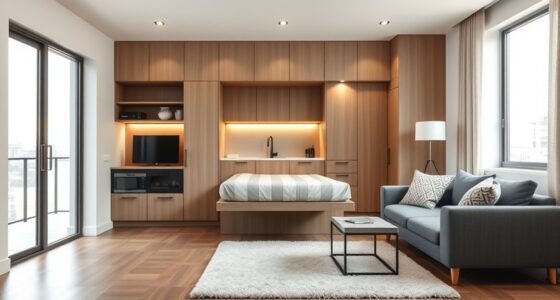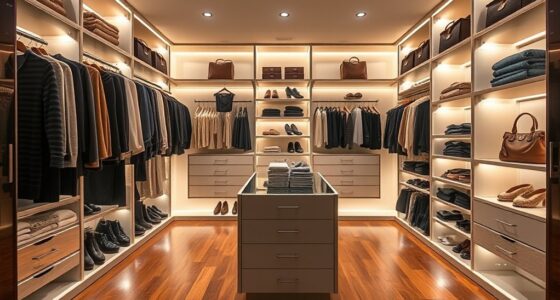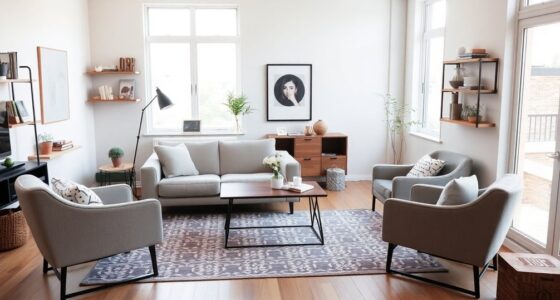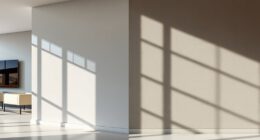To design a multi-use living room, start by choosing multifunctional furniture like sofa beds and storage ottomans that adapt to different needs. Use zoning techniques, such as furniture arrangement and rugs, to create distinct areas for work, relaxation, and entertainment. Incorporate layered lighting to set the right mood for each zone. Smart space optimization and thoughtful layout guarantee flow and functionality. Keep exploring to discover how these tips help craft a versatile, inviting space.
Key Takeaways
- Use multifunctional furniture like sofa beds and modular pieces to maximize space for work, relaxation, and entertainment.
- Define activity zones with strategic furniture arrangement, rugs, and lighting to create clear, purposeful spaces.
- Layer lighting with ambient, task, and accent options to enhance each zone’s functionality and ambiance.
- Incorporate flexible storage solutions and movable furniture to support adaptable room layouts and reduce clutter.
- Select calming decor and thoughtful layout to foster a comfortable environment that seamlessly transitions between activities.
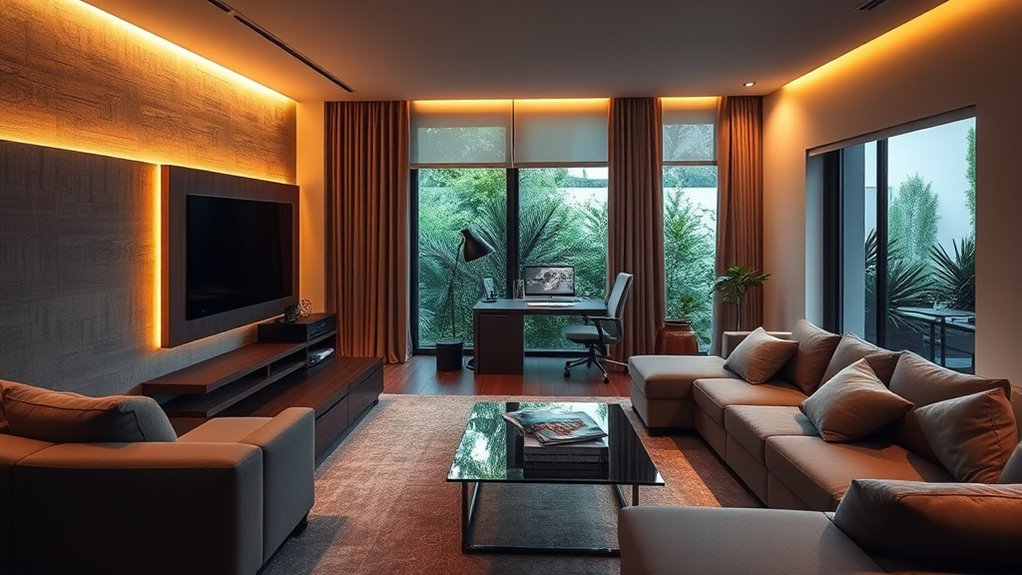
A well-designed multi-use living room seamlessly balances comfort and functionality, making it easy to switch between relaxing, working, or entertaining. To achieve this, you should focus on incorporating multifunctional furniture that serves more than one purpose. For example, a sofa bed allows you to host overnight guests without sacrificing seating during the day. Coffee tables with storage keep clutter out of sight, while ottomans can double as extra seating or footrests. These pieces maximize space without sacrificing style, giving your living room flexibility and efficiency.
Using smart zoning techniques is essential to creating a clear separation between different activities. You can define zones by arranging furniture strategically, such as placing a sofa and armchairs around a central coffee table to create a cozy relaxation area. To set up a workspace, consider positioning a small desk or a console table against a wall, separate from the lounging zone, so you can work without distractions. Rugs are also great zoning tools; a different rug under your workspace or entertainment zone visually delineates each area, helping your space feel organized and intentional.
Strategically arrange furniture and use rugs to clearly define and separate different zones.
Lighting plays a vital role in zoning as well. Use layered lighting—ambient, task, and accent—to highlight different zones. Bright, focused lighting works well over a desk or reading nook, while softer lighting creates a relaxing atmosphere in the lounge area. Adjustable lamps or dimmable overhead lights give you control over each space’s ambiance, so you can easily transition from work mode to relaxation or entertainment.
When selecting furniture, prioritize pieces that are versatile and easily movable. Lightweight chairs, foldable tables, or modular sofas allow you to reconfigure your space quickly, depending on your needs. Keep in mind that storage is crucial in a multi-use room; built-in shelving or storage ottomans help keep clutter at bay and maintain a clean, functional environment.
Additionally, incorporating elements from Floating on Water such as water-inspired decor or calming water features can enhance the relaxing ambiance of your lounge area. Finally, pay attention to flow and accessibility. Avoid blocking pathways with bulky furniture, and ensure that each zone has enough space for movement. By thoughtfully combining multifunctional furniture, zoning techniques, and strategic layout planning, you create a multi-use living room that adapts seamlessly to your lifestyle. Whether you’re unwinding, working on a project, or entertaining friends, your space will be both inviting and efficient, reflecting your needs in every detail.
Frequently Asked Questions
How Can I Maximize Space in a Small Multi-Use Living Room?
To maximize space in your small multi-use living room, choose flexible furniture like fold-out couches or storage ottomans that serve dual purposes. Use dual purpose decor, such as wall-mounted desks and multi-functional tables, to save space while maintaining style. Keep clutter minimal by organizing smartly, and utilize vertical storage solutions. These strategies make your room versatile, functional, and feel more open without sacrificing comfort or utility.
What Are the Best Lighting Options for Versatile Living Areas?
You should combine ambient lighting with task lighting to create a versatile living space. Use dimmable overhead fixtures or LED recessed lights for overall brightness, ensuring the room feels warm and inviting. Add task lights like adjustable floor lamps or desk lamps near work zones for focused illumination. This layered lighting setup lets you effortlessly switch between relaxing, working, or entertaining, making your living area both functional and cozy.
How Do I Choose Furniture That Works for Work and Relaxation?
To choose furniture that works for both work and relaxation, opt for multi-functional furniture like a sofa bed or storage ottomans to maximize space. Incorporate ergonomic seating to keep you comfortable during work sessions, preventing strain. Look for pieces with adjustable features and clean designs that seamlessly evolve from work to leisure. This way, your living room becomes a versatile space, perfect for productivity and unwinding.
What Color Schemes Enhance a Multi-Purpose Living Space?
You should choose color schemes that balance calmness and energy, guided by color psychology. Soft neutrals like beige or light gray create a relaxing backdrop, while accent colors such as blues or greens promote focus and tranquility. Incorporate vibrant accent colors like yellow or orange in accessories to add energy without overwhelming. This approach helps your multi-purpose living space feel inviting for work, relaxation, and entertainment.
How Can I Incorporate Storage Without Cluttering the Room?
You can hide your clutter in plain sight with multi functional furniture that doubles as storage, like ottomans or coffee tables with hidden compartments. Opt for sleek, multi-purpose pieces that serve dual roles, so you get plenty of storage without sacrificing style. Cleverly incorporate hidden compartments into shelves or under seating to keep essentials out of view. It’s ironic—an organized space that looks effortlessly clutter-free, all thanks to smart, hidden storage solutions.
Conclusion
Imagine your living room as a Swiss Army knife—ready for work, relaxation, and entertainment at a moment’s notice. When I redesigned my space, I found that a few clever furniture choices made all the difference, turning chaos into harmony. Just like a well-balanced tool, your living room can effortlessly adapt to your needs, creating a sanctuary that supports your busiest days and sweetest moments. With thoughtful design, your space becomes a true masterpiece of versatility.
